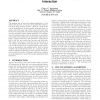Free Online Productivity Tools
i2Speak
i2Symbol
i2OCR
iTex2Img
iWeb2Print
iWeb2Shot
i2Type
iPdf2Split
iPdf2Merge
i2Bopomofo
i2Arabic
i2Style
i2Image
i2PDF
iLatex2Rtf
Sci2ools
SIGKDD
2002
2002
Towards Effective and Interpretable Data Mining by Visual Interaction
The primary aim of most data mining algorithms is to facilitate the discovery of concise and interpretable information from large amounts of data. However, many of the current formalizations of data mining algorithms have not quite reached this goal. One of the reasons for this is that the focus on using purely automated techniques has imposed several constraints on data mining algorithms. For example, any data mining problem such as clustering or association rules requires the speci cation of particular problem formulations, objective functions, and parameters. Such systems fail to take the user's needs into account very e ectively. This makes it necessary to keep the user in the loop in a way which is both e cient and interpretable. One unique way of achieving this is by leveraging human visual perceptions on intermediate data mining results. Such a system combines the computational power of a computer and the intuitive abilities of a human to provide solutions which cannot be ...
| Added | 23 Dec 2010 |
| Updated | 23 Dec 2010 |
| Type | Journal |
| Year | 2002 |
| Where | SIGKDD |
| Authors | Charu C. Aggarwal |
Comments (0)

